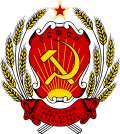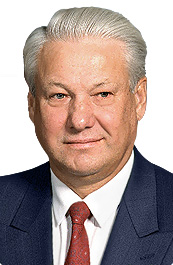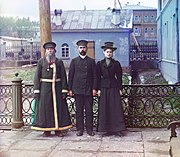
The Republics of the Union of Soviet Socialist Republics or the Union Republics were ethnically based administrative units of the Union of Soviet Socialist Republics (USSR). The Soviet Union was created by the treaty between the soviet socialist republics of Belarus, Russia, Transcaucasia and Ukraine, by which they became its constituent republics. For most of its history, the USSR was a highly centralized state; the decentralization reforms during the era of Perestroika ("Restructuring") and Glasnost ("Openness") conducted by Mikhail Gorbachev are cited as one of the factors which led to the dissolution of the USSR in 1991.

The Transcaucasian Socialist Federative Soviet Republic, also known as the Transcaucasian Soviet Federative Socialist Republic, was a republic of the Soviet Union that existed from 1922 to 1936.
The Presidium of the Supreme Soviet of the Russian Soviet Federative Socialist Republic was the official head of state of the Russian Soviet Federative Socialist Republic between 1938 and 1990. It was elected by the Supreme Soviet of the Russian Soviet Federative Socialist Republic to perform the Supreme Soviet's activities when it was not in session, in which, in practice, was most of the year.

An index of articles related to the former nation known as the Soviet Union. It covers the Soviet revolutionary period until the dissolution of the Soviet Union. This list includes topics, events, persons and other items of national significance within the Soviet Union. It does not include places within the Soviet Union, unless the place is associated with an event of national significance. This index also does not contain items related to Soviet Military History.
A People's Commissariat was a structure in the Soviet state from 1917–1946 which functioned as the central executive body in charge of managing a particular field of state activity or a separate sector of the national economy; analogue of the ministry. As a rule, the People's Commissariat was headed by the People’s Commissar, which is part of the government – the Council of People's Commissars of the appropriate level.
The All-Russian Central Executive Committee was the highest legislative, administrative and revising body of the Russian Soviet Federative Socialist Republic from 1917 until 1937. Although the All-Russian Congress of Soviets had supreme authority, in periods between its sessions its powers were passed to VTsIK.

The Ukrainian Soviet Republic was one of the names of the earlier Soviet Ukrainian quasi-state formations, a pro-Bolshevik Soviet government that resided in Kharkiv.

The flag of the Transcaucasian Socialist Federative Soviet Republic was adopted by the Transcaucasian Socialist Federative Soviet Republic in 1925. It consists of a red star bordered by gold in the canton, surrounded by a semicircle with the letters "ЗСФСР" in gold.

The Declaration of State Sovereignty of the Russian SFSR was a political act of the Russian SFSR, then part of the Soviet Union, which marked the beginning of constitutional reform in Russia. The Declaration was adopted by the First Congress of People's Deputies of the Russian SFSR on 12 June 1990. It proclaimed the sovereignty of the Russian SFSR and the intention to establish a democratic constitutional state within a liberalized Soviet Union. The declaration also states the following:

The Supreme Soviet of the Russian SFSR, later Supreme Soviet of the Russian Federation was the supreme government institution of the Russian SFSR in 1938–1990; in 1990–1993 it was a permanent legislature (parliament), elected by the Congress of People's Deputies of the Russian Federation).

The Russian Soviet Federative Socialist Republic, previously known as the Russian Soviet Republic and the Russian Socialist Federative Soviet Republic as well as being unofficially known as Soviet Russia, Russian Federation or simply Russia, was an independent socialist state from 1917 to 1922, and afterwards the largest and most populous of the Soviet socialist republics of the Soviet Union (USSR) from 1922 to 1991, until becoming a sovereign part of the Soviet Union with priority of Russian laws over Union-level legislation in 1990 and 1991, the last two years of the existence of the USSR. The Russian Republic was composed of sixteen smaller constituent units of autonomous republics, five autonomous oblasts, ten autonomous okrugs, six krais and forty oblasts. Russians formed the largest ethnic group. The capital of the Russian SFSR was Moscow and the other major urban centers included Leningrad, Novosibirsk, Sverdlovsk, Gorky and Kuybishev.
The Government of the Soviet Union, formally the All-Union Government of the Union of Soviet Socialist Republics, commonly abbreviated to Soviet Government, was the executive and administrative organ of state in the former Soviet Union. It had three different names throughout its existence; Council of People's Commissars (1923–1946), Council of Ministers (1946–1991) and Cabinet of Ministers (1991).

The All-Union Central Executive Committee was the most authoritative governing body of the USSR during the interims of the sessions of the All-Union Congress of Soviets. Established in 1922 by the First All-Union Congress of Soviets, in 1938 it was replaced by the Presidium of the Supreme Soviet of first convocation.

The Council of People's Commissars of the Russian Soviet Federative Socialist Republic was the government of Soviet Russia in 1917–1946. It was established by the Second All-Russian Congress of Soviets of Workers', Soldiers', and Peasants' Deputies on November 7, 1917 "as an interim workers' and peasants' government" under the name of the Council of People's Commissars, which was used before the adoption of the Constitution of the Russian Socialist Federative Soviet Republic of 1918.

The Declaration and Treaty on the Formation of the Union of Soviet Socialist Republics officially created the Union of Soviet Socialist Republics (USSR), commonly known as the Soviet Union. It de jure legalised a union of several Soviet republics that had existed since 1919 and created a new centralised federal government where key functions were centralised in Moscow.

The coat of arms of the Russian Soviet Federative Socialist Republic (RSFSR) was adopted on 10 July 1918 by the government of the Russian Soviet Federative Socialist Republic, and modified several times afterwards. It shows wheat as the symbol of agriculture, a rising sun for the future of the Russian nation, the red star as well as the hammer and sickle for the victory of Communism and the "world-wide socialist community of states".































